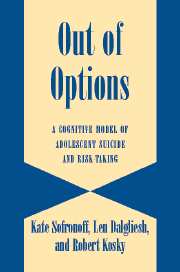Book contents
- Frontmatter
- Contents
- Preface
- Introduction
- 1 Adolescent Suicide: An Overview of the Epidemiology
- 2 Risk and Predisposing Factors in Adolescent Suicide
- 3 Emotional Problems and Adolescent Suicide
- 4 Adolescent Suicide: Cognitive Variables
- ADOLESCENT RISK-TAKING
- A MODEL OF SUICIDE AND RISK-TAKING
- AN EVALUATION OF THE S/RT MODEL
- IMPLICATIONS FOR TREATMENT
- References
- Index
2 - Risk and Predisposing Factors in Adolescent Suicide
Published online by Cambridge University Press: 03 September 2009
- Frontmatter
- Contents
- Preface
- Introduction
- 1 Adolescent Suicide: An Overview of the Epidemiology
- 2 Risk and Predisposing Factors in Adolescent Suicide
- 3 Emotional Problems and Adolescent Suicide
- 4 Adolescent Suicide: Cognitive Variables
- ADOLESCENT RISK-TAKING
- A MODEL OF SUICIDE AND RISK-TAKING
- AN EVALUATION OF THE S/RT MODEL
- IMPLICATIONS FOR TREATMENT
- References
- Index
Summary
Introduction
It is commonly accepted that there are risk factors and personal vulnerabilities that make a person more likely to attempt suicide or to commit suicide. These factors include sociocultural and individual influences. Durkheim (1897) considered social and cultural factors to be the major influence on suicidal behavior. In fictional literature, such as Shakespeare's story of Romeo and Juliet, the stress of personal relationships was often foregrounded as a powerful influence. Freud also considered suicide to be a psychological act, with personal problems and sociocultural pressures, such as school expectations, contributing to the outcome. The literature continues to debate the relative importance of individual, psychiatric, and environmental stressors in explaining suicidal behavior; the following review highlights the complexity of the interrelationships among these factors.
Environmental Variables
STRESSFUL LIFE EVENTS
Stressful life events or recent family difficulties have been found to precede most adolescent suicide attempts. The most common problems that occur in the weeks before an adolescent suicide or suicide attempt include relationship breakups, interpersonal conflict, and difficulties with discipline and the law (Shaffer & Piacentini, 1994). Unresolved conflict within the family and a lack of closeness between family members are also commonly reported (Kosky, Silburn, & Zubrick, 1990b; Watt & Sharp, 2001). This implies that many suicidal adolescents do not feel supported by their family when they feel at their most vulnerable.
- Type
- Chapter
- Information
- Out of OptionsA Cognitive Model of Adolescent Suicide and Risk-Taking, pp. 17 - 30Publisher: Cambridge University PressPrint publication year: 2004
- 2
- Cited by



